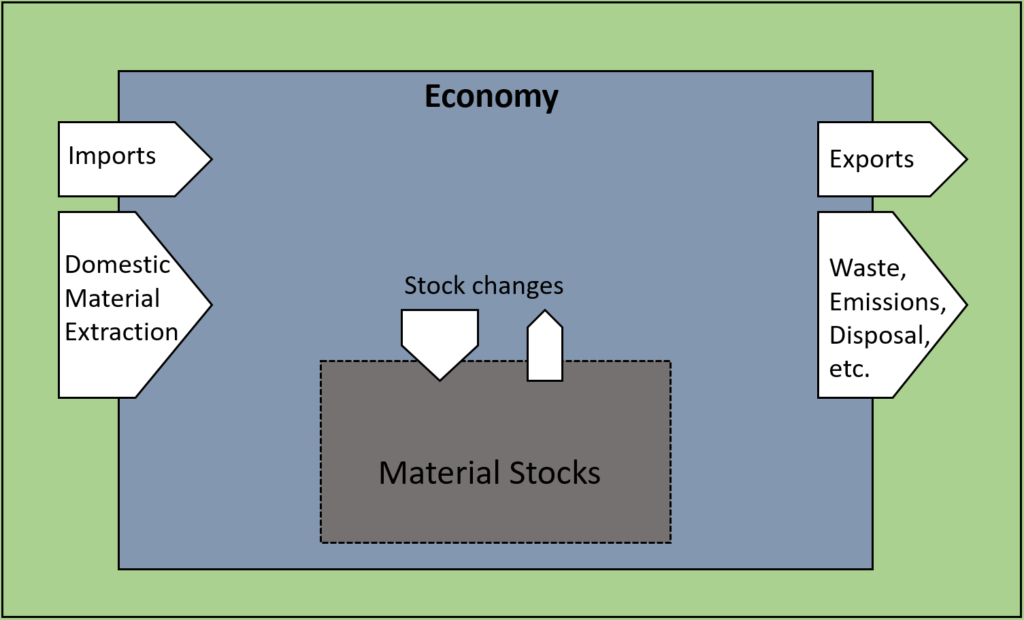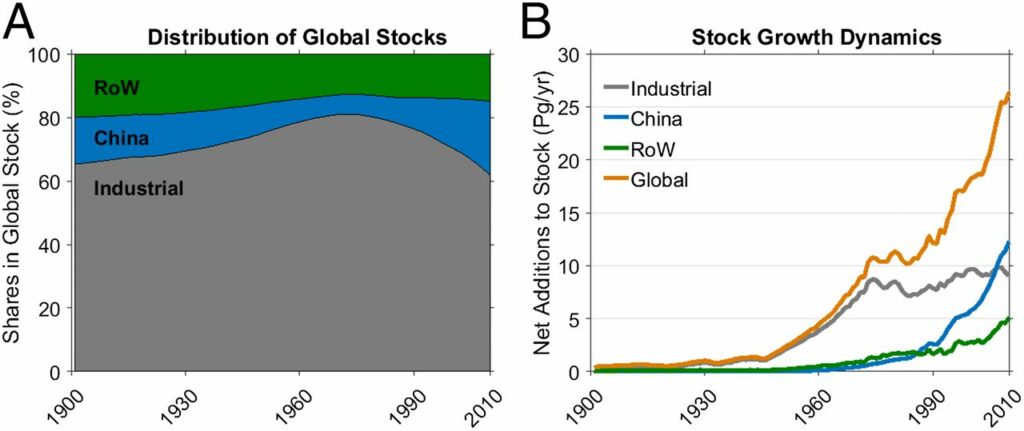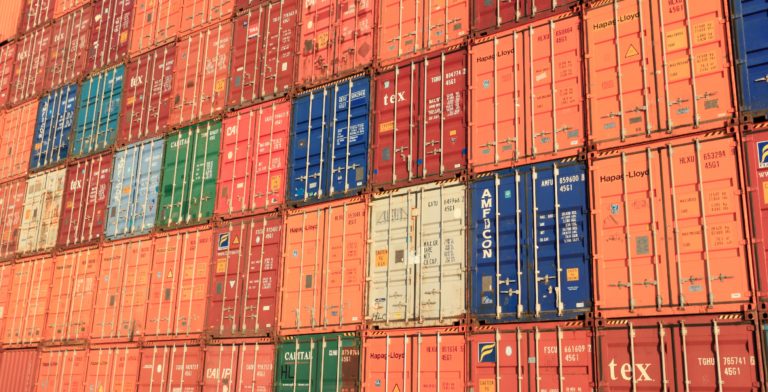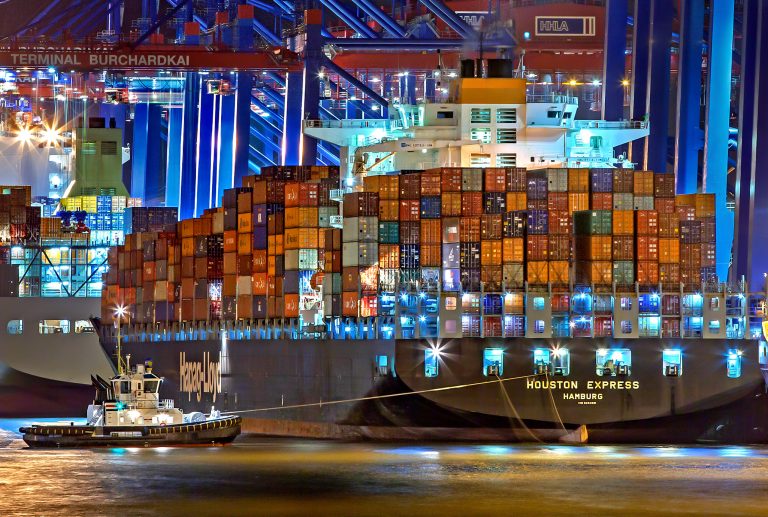Why material stocks matter
A large share of the globally extracted raw materials accumulates in buildings, infrastructures, and durable goods. They provide societies with services such as shelter, communication and transport. As these materials – practically or theoretically can be reused by society, they are called “material stock” or „anthropogenic stock“.
Building material stocks itself is a central driver for resource flows, as housing, transport or energy infrastructure require huge amounts of non-renewable materials, such as sand and gravel or steel, energy or water. But once they are built, stocks also require a steady inflow of resources for its use, as well as for its maintenance and renewal (e.g. lighting systems, roads, etc.). Hence, the decision on how to design the anthropogenic stock also determines long-term patterns of raw materials and energy use, as well as resulting waste flows, recycling potentials and greenhouse gas emissions.
So far, Material Flow Analysis (MFA) research mostly focused on accounting for material flows such as domestic material extraction, material consumption, or waste flows. Not least against the backdrop of climate change mitigation, more and more research on material stocks or the so-called “stock-flow service nexus” is carried out to understand the inter-relations between material and energy flows (and related carbon emissions) and material stocks. However, estimating material stocks is a complex and comparatively new area within Material Flow Accounting. (Haberl et al. 2021)
How to quantify material stocks
One approach to quantify the amount of material stocks within an economy is to apply the mass-balance between inputs and outputs. By adding up material inflows (Domestic extraction and imports of materials) and subtracting outflows (exports and emissions, waste etc.), material accumulation (also called “Net Additions to Stocks”, NAS) is calculated (for further information on MFA and derived indicators, see our methods-section) (see the figure below). In order to also understand the composition and dynamics of stocks themselves, this method can be extended with different modelling approaches, e.g. accounting also for flows of secondary (re- or down-cycled) materials.

Source: Adapted from Krausmann et al. (2017)
Another method is to apply satellite-driven approaches that use spatially explicit data to estimate the physical dimensions (area, height and volume) of buildings and infrastructures. The calculated volume of different structures is then converted into mass units through multiplication with corresponding material intensity coefficients. This method also allows for the mapping of stocks of buildings and infrastructures. One of these approaches is the use of night-time lights data to estimate built-up area based on differences in areas‘ radiance. (Peled et al. 2021)
Due to data gaps as well as methodological differences among data sources, so far material stocks can only be roughly estimated. However, existing estimates can already illustrate the magnitude of anthropogenic stocks and allows for comparing them to their related material flows.
Global material stocks
A study by Wiedenhofer et. al (2019) showed that about half of the raw materials extracted each year on the globe are used for the build-up of new stocks or the maintenance of stocks currently in use. In the year 2014, globally the anthropogenic stock increased to 792 billion tonnes.
From 1990 up to 2014, global material processing (material extraction together with re- and downcycling of materials) grew 12-fold. However, in the same period the share of those extracted materials that accumulate in material stocks increased 30-fold. (Wiedenhofer et al. 2019)
There are large differences between high-income industrial countries and the rest of the world (including countries of the Global South) regarding the trends of stock growth as well as their share in global stocks (see figure below).

Source: Krausmann et al. 2017
The figure above shows that from 1900 to 2010, industrial countries held the largest share in global material stocks. The accumulation mainly took place in the period after World War II until 1970. From the 1990s onwards, China was increasing its net additions to stock (balance between inputs and outputs, see above) and surpassed those of the industrial countries. By 2010, China owned 22 % of the global stocks, in comparison to 60 % located in the industrialized countries. The rest of the world had a share of 18 % in global stocks in 2010, whereas its population made up 62 % of the global population. Hence, large differences of per-capita stocks existed between industrial countries, China and the rest of the world. Since then, more and more countries are developing industrial consumption patterns. Hence, significant growth of global anthropogenic stocks can be assumed for the rest of the world. (Krausmann et al. 2017)
Globally, the most important materials linked to the build-up of stocks are non-metallic minerals, especially sand and gravel for concrete production. Other important construction materials include metals (most importantly iron ore for steel production) and bitumen for road construction.
The indicator “domestic extraction” of a country accounts for the amount of materials extracted in the country in one year to either produce consumer goods or build up stocks. Comparing the composition of material extraction per capita in the regions Africa, China and Europe in 2024 illustrates the different growth dynamics of stocks in different world regions (see figure below). Whereas in Africa the per-capita extraction of non-metallic minerals amounted to only 1.7 tonnes, in Europe it was 10.8 tonnes per capita and in China 16.7 tonnes per capita in 2024.
Note: Hover over the graph to view the respective values. To access and modify this visualisation open it via the visualisation tool.
How stocks are hindering sustainable material use
Circular economy strategies aim at the reduction of overall material extraction to reduce pressure on the environment (for more information, see our specific stories: “Circular Economy: a smart way of using materials” or “Tracking Progress Towards Circularity”). One important element of these strategies is to close material loops, for instance, through recycling, and hence target output flows. Examples for this approach are the use of construction waste or “urban mining” of metals. In both cases materials from stocks are used as secondary raw materials.
However, considering material stocks in addition to flows raises doubts about how circular our economy can become. This is due to two reasons: (1) Only half of all materials extracted and used globally can potentially be recycled. The other half is used as food, feed or for energy provision. (2) The global accumulation of material stocks is ongoing. Stocks remain in service for a long time. Consequently they are not available for reuse or recycling and, in contrast require new materials and other resources for their maintenance. Consequently, the growing volume of anthropogenic stocks will be one of the key future sustainability challenges (Haas et al. 2020).
References
Haas, W.; Krausmann, F.; Wiedenhofer, D.; Lauk, C.; Mayer, A. (2020): Spaceship earth’s odyssey to a circular economy – a century long perspective. In: Resources, Conservation and Recycling 163, S. 105076. DOI: 10.1016/j.resconrec.2020.105076.
Haberl, H.; Schmid, M.; Haas, W.; Wiedenhofer, D.; Rau, H.; Winiwarter, V. (2021): Stocks, flows, services and practices: Nexus approaches to sustainable social metabolism. In: Ecological Economics 182, S. 106949. DOI: 10.1016/j.ecolecon.2021.106949.
Krausmann, F.; Wiedenhofer, D.; Lauk, C.; Haas, W.; Tanikawa, H.; Fishman, T. et al. (2017): Global socioeconomic material stocks rise 23-fold over the 20th century and require half of annual resource use. In: PNAS 114 (8), S. 1880–1885. DOI: 10.1073/pnas.1613773114.
Krausmann, F.; Schandl, H.; Eisenmenger, N.; Giljum, S.; Jackson, T. (2017): Material Flow Accounting: Measuring Global Material Use for Sustainable Development. In: Annu. Rev. Environ. Resour. 42 (1), S. 647–675. DOI: 10.1146/annurev-environ-102016-060726.
Peled, Y.; Fishman, T. (2021): Estimation and mapping of the material stocks of buildings of Europe: a novel nighttime lights-based approach. In: Resources, Conservation and Recycling 169, S. 105509. DOI: 10.1016/j.resconrec.2021.105509.
Wiedenhofer, D.; Fishman T.; Lauka, C.; Haas, W.; Krausmann, F. (2019): Integrating Material Stock Dynamics Into Economy-Wide Material Flow Accounting: Concepts, Modelling, and Global Application for 1900–2050. In: Ecological Economics 156, S. 121–133. DOI: 10.1016/j.ecolecon.2018.09.010.


